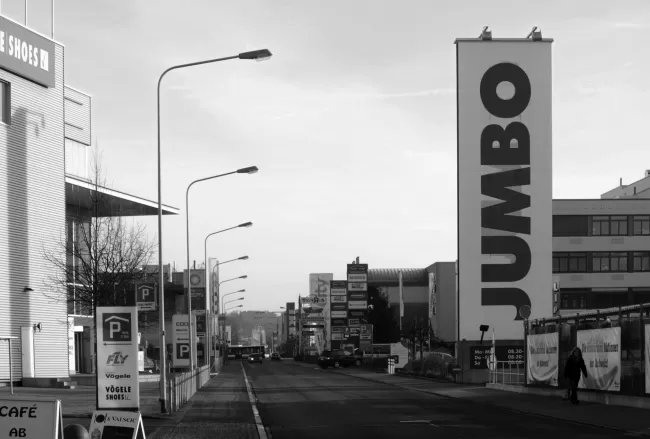Twin Cities

Diet(l)ikon
© E2ATwo suburbs with confusingly similar names have become cities. Dietlikon und Dietikon are twins, and their obvious, confounding similarity is the motor of remarkable, parallel development.
Everything that exists in Dietlikon also exists in Dietikon; this parallel is not merely a phenomenon of morphological parity, but of identical commercial strips, highly specialized and simultaneously improvised conglomerates for consumer goods, which supply the suburban belt far and wide with any product the imagination can devise.
Accessible by means of the newly developed exit lanes and traffic jams, one can enter these new centers before reaching the highways, which are impressive for their temporary populations shortly before closing time and which, to a certain extent, declare a state of emergency as normalcy. They produce an efficient public, who sticks strictly to store hours and disappears as rapidly as possible thereafter. The fear of being confused with the other is so latent that new phenomena are adopted and adapted within the shortest time span possible; a duplication process which is directed at the infrastructure and outfitting of both places.
In this way, one is protected from a mix-up and can be sure that nothing has been missed. Like two opposing bulwarks, these suburbs lie before the actual city, attaching to the highway and seducing customers with their simple structure. And thus evolves a motor city, which almost anachronistically recalls images from the 1960s, and with its symbolism, serves as a reminder of the “strip.” In doing so, the suburbs need not concern themselves with the ugliness of the ordinary; far from the field of view of “correct” planning, they can improvise and run amok with the short-lived nature of their existence. In the attempt to depict the needs of mass culture, both sides polarize the established city. When, in 1965, Tom Wolfe explained that in Vegas it was not important that the city was built by gangsters, but rather that its founders were mostly proles, he refers to the formulation of a popular consumer culture that had long ago taken its shape and form.1 How removed both of the little Diet(l)ikons are from seeing themselves as symbols of popular culture remains an open question. One thing is certain: their origins as villages lie far away and have nothing to do with the new, increasingly larger volumes that turned the former lightness and elegance of their figures into heavy, massive structures.